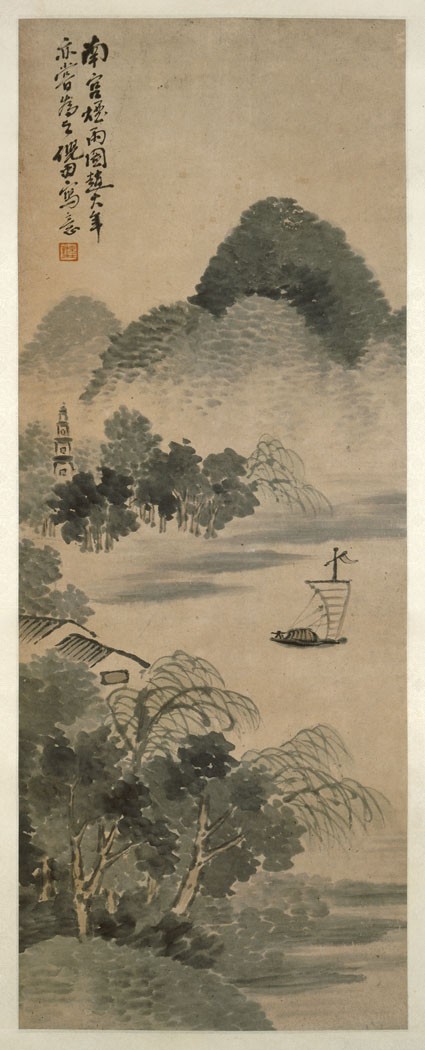Chinese Paintings in the Ashmolean Museum, Oxford
A catalogue of the Ashmolean collection of Chinese paintings by Shelagh Vainker (published Oxford, 2000).

Publications online: 222 objects
- Reference URL
Actions
Misty Rain in the Style of Nangong
-
Literature notes
Ni Tian was from Yangzhou in Jiangsu, where as a painter he followed the eighteenth-century Yangzhou eccentric, Hua Yan. He first studied painting with Wang Su, and specialised in figures and Buddhist images. He settled in Shanghai, probably during the late 1880s or early 1890s, and he appears then to have immersed himself in the Shanghai School, with a particular regard for its leading painter, Ren Yi (d. 1895, q.v.). He has been credited with carrying forward Ren's style to a third generation of Shanghai painters. He was also well-known as a dealer in paintings. -
Description
Ni Tian was from Yangzhou in Jiangsu province, where as a painter he followed the eighteenth century Yangzhou eccentric, Hua Yan (1682-c.1756). He studied painting with Wang Su (1794-1877), where he specialized in figures and Buddhist images. After settling in Shanghai, he immersed himself in the Shanghai School, and was particularly influenced by its leading painter Ren Yi (1840-1896).
The inscription explains this painting is in the style of Nangong, also known as Mi Fu (1051-1107). The artist also notes ‘Zhao Danian [aka Zhao Lingrang (active c.1048-1100)] used to do it too’. Zhao Danian, also known as Zhao Lingrang, was a member of the Northern Song (AD 960-1127) imperial family, and is known for his blue-and-gold landscapes.
-
Details
- Associated place
-
Asia › China › Shanghai province (probable place of creation)
- Date
- 1855 -1919
- Material and technique
- ink and slight colour on paper
- Dimensions
- 87 x 33 cm (height x width)
- Material index
- Technique index
- Object type index
- No. of items
- 1
- Credit line
- Purchased, 1991.
- Accession no.
- EA1991.187
-
Further reading
Vainker, Shelagh, Chinese Paintings in the Ashmolean Museum, Oxford (Oxford: Ashmolean Museum, 2000), no. 104 on p. 122, illus. p. 123 fig. 104
Past Exhibition
see (1)Location
-
- currently in research collection
Objects are sometimes moved to a different location. Our object location data is usually updated on a monthly basis. Contact the Jameel Study Centre if you are planning to visit the museum to see a particular object on display, or would like to arrange an appointment to see an object in our reserve collections.
Publications online
-

Chinese Paintings in the Ashmolean Museum, Oxford
Ni Tian was from Yangzhou in Jiangsu, where as a painter he followed the eighteenth-century Yangzhou eccentric, Hua Yan. He first studied painting with Wang Su, and specialised in figures and Buddhist images. He settled in Shanghai, probably during the late 1880s or early 1890s, and he appears then to have immersed himself in the Shanghai School, with a particular regard for its leading painter, Ren Yi (d. 1895, q.v.). He has been credited with carrying forward Ren's style to a third generation of Shanghai painters. He was also well-known as a dealer in paintings.
Notice
Object information may not accurately reflect the actual contents of the original publication, since our online objects contain current information held in our collections database. Click on 'buy this publication' to purchase printed versions of our online publications, where available, or contact the Jameel Study Centre to arrange access to books on our collections that are now out of print.
© 2013 University of Oxford - Ashmolean Museum


